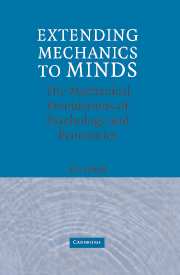
-
Select format
-
- Publisher:
- Cambridge University Press
- Publication date:
- 21 September 2009
- 22 May 2006
- ISBN:
- 9780511546952
- 9780521861977
- Dimensions:
- (228 x 152 mm)
- Weight & Pages:
- 0.754kg, 476 Pages
- Dimensions:
- Weight & Pages:
You may already have access via personal or institutional login
Book description
This book deploys the mathematical axioms of modern rational mechanics to understand minds as mechanical systems that exhibit actual, not metaphorical, forces, inertia, and motion. Using precise mental models developed in artificial intelligence the author analyzes motivation, attention, reasoning, learning, and communication in mechanical terms. These analyses provide psychology and economics with new characterizations of bounded rationality; provide mechanics with new types of materials exhibiting the constitutive kinematic and dynamic properties characteristic of different kinds of minds; and provide philosophy with a rigorous theory of hybrid systems combining discrete and continuous mechanical quantities. The resulting mechanical reintegration of the physical sciences that characterize human bodies and the mental sciences that characterize human minds opens traditional philosophical and modern computational questions to new paths of technical analysis.
Reviews
This is an extraordinary treatise providing insight into a broad range of interrelated topics that have puzzled philosophers for millennia and occupied researchers in artificial intelligence, economics, cognitive science and psychology for as long as these disciplines have existed. Doyle has himself been studying these topics for over two decades and has probably done more than any other scholar to bring to bear the perspectives and insights offered by these disciplines and then to craft a new theory that borrows from the past but considerably expands the explanatory power of previous theories.
Thomas Dean, Brown University
Contents
Metrics
Altmetric attention score
Full text views
Full text views help Loading metrics...
Loading metrics...
* Views captured on Cambridge Core between #date#. This data will be updated every 24 hours.
Usage data cannot currently be displayed.
Accessibility standard: Unknown
Why this information is here
This section outlines the accessibility features of this content - including support for screen readers, full keyboard navigation and high-contrast display options. This may not be relevant for you.
Accessibility Information
Accessibility compliance for the PDF of this book is currently unknown and may be updated in the future.


